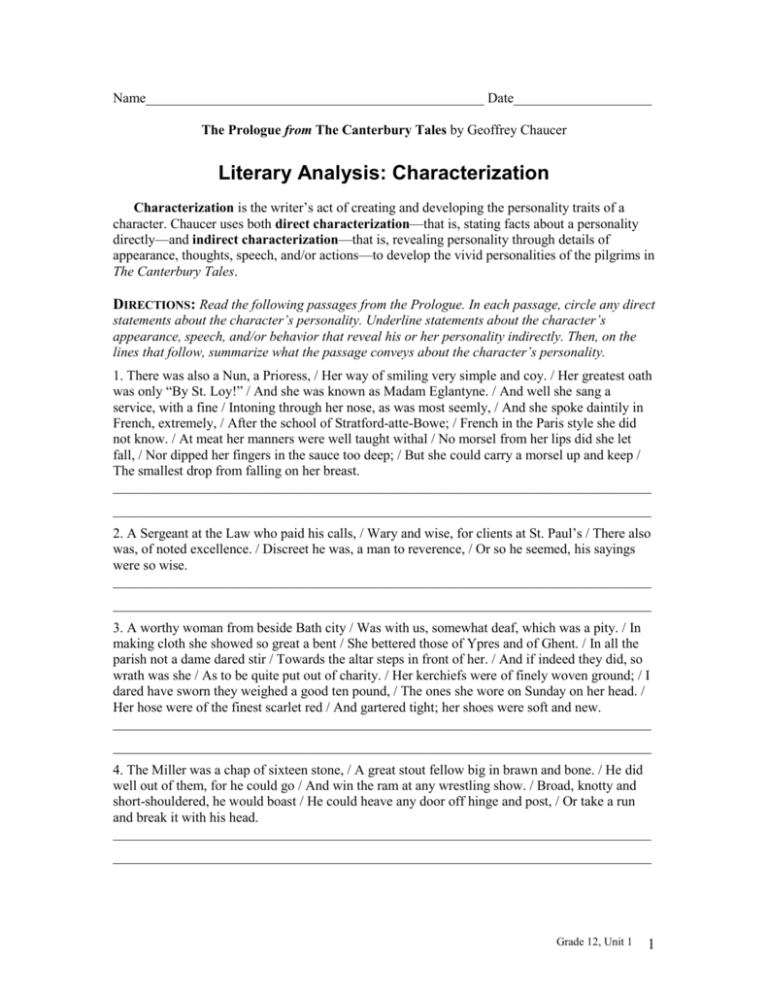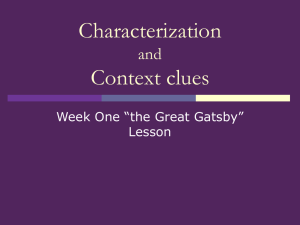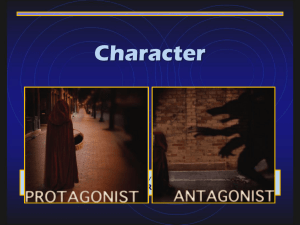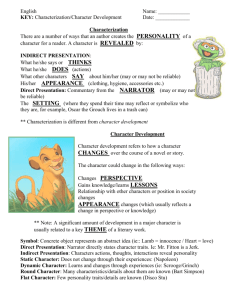Lit15_g12_u1_cha1_LA1
advertisement

Name_________________________________________________ Date____________________ The Prologue from The Canterbury Tales by Geoffrey Chaucer Literary Analysis: Characterization Characterization is the writer’s act of creating and developing the personality traits of a character. Chaucer uses both direct characterization—that is, stating facts about a personality directly—and indirect characterization—that is, revealing personality through details of appearance, thoughts, speech, and/or actions—to develop the vivid personalities of the pilgrims in The Canterbury Tales. DIRECTIONS: Read the following passages from the Prologue. In each passage, circle any direct statements about the character’s personality. Underline statements about the character’s appearance, speech, and/or behavior that reveal his or her personality indirectly. Then, on the lines that follow, summarize what the passage conveys about the character’s personality. 1. There was also a Nun, a Prioress, / Her way of smiling very simple and coy. / Her greatest oath was only “By St. Loy!” / And she was known as Madam Eglantyne. / And well she sang a service, with a fine / Intoning through her nose, as was most seemly, / And she spoke daintily in French, extremely, / After the school of Stratford-atte-Bowe; / French in the Paris style she did not know. / At meat her manners were well taught withal / No morsel from her lips did she let fall, / Nor dipped her fingers in the sauce too deep; / But she could carry a morsel up and keep / The smallest drop from falling on her breast. ______________________________________________________________________________ ______________________________________________________________________________ 2. A Sergeant at the Law who paid his calls, / Wary and wise, for clients at St. Paul’s / There also was, of noted excellence. / Discreet he was, a man to reverence, / Or so he seemed, his sayings were so wise. ______________________________________________________________________________ ______________________________________________________________________________ 3. A worthy woman from beside Bath city / Was with us, somewhat deaf, which was a pity. / In making cloth she showed so great a bent / She bettered those of Ypres and of Ghent. / In all the parish not a dame dared stir / Towards the altar steps in front of her. / And if indeed they did, so wrath was she / As to be quite put out of charity. / Her kerchiefs were of finely woven ground; / I dared have sworn they weighed a good ten pound, / The ones she wore on Sunday on her head. / Her hose were of the finest scarlet red / And gartered tight; her shoes were soft and new. ______________________________________________________________________________ ______________________________________________________________________________ 4. The Miller was a chap of sixteen stone, / A great stout fellow big in brawn and bone. / He did well out of them, for he could go / And win the ram at any wrestling show. / Broad, knotty and short-shouldered, he would boast / He could heave any door off hinge and post, / Or take a run and break it with his head. ______________________________________________________________________________ ______________________________________________________________________________ Grade 12, Unit 1 1 ANSWERS The Prologue from The Canterbury Tales by Geoffrey Chaucer Literary Analysis: Characterization 1. Circled item(s) (direct characterization) should include the following: “she was known as Madam Eglantyne” (indirect characterization:) Her way of smiling very simple and coy. / Her greatest oath was only “By St. Loy!”; well she sang a service, with a fine / Intoning through her nose, as was most seemly; she spoke daintily in French, extremely, / After the school of Stratford-atte- Bowe; French in the Paris style she did not know; At meat her manners were well taught withal/No morsel from her lips did she let fall,/Nor dipped her fingers in the sauce too deep;/But she could carry a morsel up and keep/The smallest drop from falling on her breast. Sample answer: The Nun is the kind of person who tries to act like a well-mannered and delicate lady but is actually rather vain, affected, and lower-class. 2. Circled item(s) (direct characterization) should include the following: “Wary and wise”; “Discreet he was”; “of noted excellence” (indirect characterization:) who paid his calls; for clients at St. Paul’s; a man to reverence, / Or so he seemed, his sayings were so wise. Sample answer: The Sergeant at the Law seems to be a man who boasts of his own discretion and accomplishments and feels himself wise enough to make remarks for the benefit of others—all of which suggests that he may be more “wary, wise, and discreet” in his own opinion than he actually is. 3. Circled item(s) (direct characterization) should include the following: “worthy woman”; somewhat deaf”; “Her hose were of the finest scarlet red/And gartered tight; her shoes were soft and new.” (indirect characterization:) In making cloth she showed so great a bent / She bettered those of Ypres and of Ghent. / In all the parish not a dame dared stir / Towards the altar steps in front of her. / And if indeed they did, so wrath was she / As to be quite put out of charity. / Her kerchiefs were of finely woven ground; / I dared have sworn they weighed a good ten pound, / The ones she wore on Sunday on her head. Sample answer: This woman appears to be a vain, materialistic, competitive, show-off type of person. 4. Circled item(s) (direct characterization) should include the following: “a chap of sixteen stone./A great stout fellow big in brawn and bone”; “Broad, knotty and short-shouldered” (indirect characterization:) he could go / And win the ram at any wrestling show: he would boast / He could heave any door off hinge and post, / Or take a run and break it with his head. Sample answer: The Miller is the kind of person who relies on his brute strength, is proud of his physique and abilities, and isn’t very smart. Grade 12, Unit 1 2








